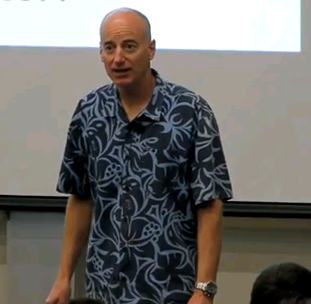UCI Chem 131C Thermodynamics and Chemical Dynamics (Spring 2012)
Lec 02. Thermodynamics and Chemical Dynamics -- The Boltzmann Distribution Law --
View the complete course: ../courses/chem_131c_thermodynamics_and_chemical_dynamics.html
Instructor: Reginald Penner, Ph.D.
License: Creative Commons BY-NC-SA
Terms of Use: ../info.
More courses at http://ocw.uci.edu
Description: In Chemistry 131C, students will study how to calculate macroscopic chemical properties of systems. This course will build on the microscopic understanding (Chemical Physics) to reinforce and expand your understanding of the basic thermo-chemistry concepts from General Chemistry (Physical Chemistry.) We then go on to study how chemical reaction rates are measured and calculated from molecular properties. Topics covered include: Energy, entropy, and the thermodynamic potentials; Chemical equilibrium; and Chemical kinetics. This video is part of a 27-lecture undergraduate-level course titled "Thermodynamics and Chemical Dynamics" taught at UC Irvine by Professor Reginald M. Penner.
Thermodynamics and Chemical Dynamics (Chem 131C) is part of OpenChem: ../openchem/.
Recorded on April 4, 2012.
Index of Topics:
01:48 - About Quiz I
04:17 - The Boltzmann Distribution Law
04:21 - What's in This Lecture?
04:44 - Consider a Harmonic Oscillator-Like State Distribution
05:04 - Now imagine that you have a 3-dimensional array of these "molecules"
06:28 - now let's add three quanta of energy to these three molecules.
06:52 - One option is to put all three quanta into one molecule.
07:40 - We shall refer to ech of these possibilities as a microstate;
07:44 - Notation for Specifying a particular configuration (families of microstates)
08:50 - Configuration Example
09:04 - Configuration Example (I, II, III)
09:59 - Configuration II Example
11:11 - Configuration I Example
14:13 - Configuration III Example
14:41 - Formula - The Number of Microstates, W, for a Particular Configuration
15:09 - Example: Consider a system of eight molecules containing four energy quota...
17:16 - How about 5 quanta in ten "molecules" (example)?
19:07 - How about 5 quanta in ten "molecules" (example II)?
20:27 - Curious: configuration VI is favored by more than 2:1 compared the others...
21:31 - Now what happens as we increase the number of molecules?
22:14 - Flipping a Coin Example
22:55 - Flipping a Coin Outcomes and Possibilities
23:24 - N coin flips, the preference of the system for the most probably configuration increases with N...
27:32 - Question: What does the big "N" stand for on Cornhuskers Stadium?
27:57 - Knowledge of this highly preferred configuration equates to knowledge of the system as a whole!
28:17 - Configuration VI is favored by more than 2:1 compared with any other...
28:21 - ...two ways to find this highly preferred configuration...
28:41 - Knowledge of this highly preferred configuration equates to knowledge of the system as a whole!
29:48 - Consider an isolated (N & Q constant) macroscopic (N large etc.) assembly of N...
31:41 - Graphic Representation
33:28 - Number of Microstates Before and After
35:46 - ...substituting from the expressions for energy defined earlier we have...
37:25 - ...this means that the left and right sides of this equality are constants, call this constant B (beta)
39:31 - The Boltzmann Distribution Law (Formula)
41:45 - Example (Solving for N)
43:07 - Molecular Partition Function, q: Two Versions (Figure)
44:17 - Example: What are the relative populations of the states of a two level system...
47:33 - Example: A certain atom has a threefold degenerate ground level...
52:33 - How much Thermal Energy is in the System? (Figure)
Required attribution: Penner, Reginald Thermodynamics and Chemical Dynamics 131C (UCI OpenCourseWare: University of California, Irvine), ../courses/chem_131c_thermodynamics_and_chemical_dynamics.html. [Access date]. License: Creative Commons Attribution-ShareAlike 3.0 United States License.


